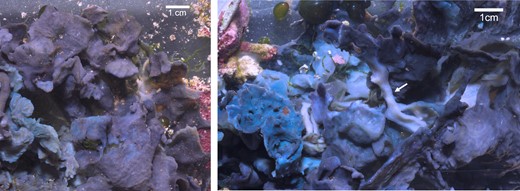2023-06-29 ミュンヘン大学(LMU)
◆海綿は、マイクロバイオームの変化に応じて形態を変化させる能力を持っており、これは進化の初期において海綿とマイクロバイオームの相互作用が発展したことを示唆しています。
◆研究者たちは、海綿の遺伝子活性に及ぼすマイクロバイオームの影響を調査し、海綿がマイクロバイオームの変化に主体的に応答することを示しました。この研究は、動物とバクテリアの共通の進化的な歴史と、マイクロバイオームが動物の栄養と発育において重要な役割を果たしていることを強調しています。
<関連情報>
- https://www.lmu.de/en/newsroom/news-overview/news/sponges-and-their-microbiome-interacting-for-millions-of-years.html
- https://academic.oup.com/mbe/article/doi/10.1093/molbev/msad138/7191912
海綿におけるボディプランの再編成はマイクロバイオームの変化と相関する Body-Plan Reorganization in a Sponge Correlates with Microbiome Change
Sergio Vargas, Laura Leiva, Michael Eitel, Franziska Curdt, Sven Rohde, Christopher Arnold, Michael Nickel, Peter Schupp, William D Orsi, Maja Adamska,Gert Wörheide
Molecular Biology and Evolution Published:08 June 2023
DOI:https://doi.org/10.1093/molbev/msad138

Abstract
Mounting evidence suggests that animals and their associated bacteria interact via intricate molecular mechanisms, and it is hypothesized that disturbances to the microbiome influence animal development. Here, we show that the loss of a key photosymbiont (i.e., bleaching) upon shading correlates with a stark body-plan reorganization in the common aquarium cyanosponge Lendenfeldia chondrodes. The morphological changes observed in shaded sponges include the development of a thread-like morphology that contrasts with the flattened, foliose morphology of control specimens. The microanatomy of shaded sponges markedly differed from that of control sponges, with shaded specimens lacking a well-developed cortex and choanosome. Also, the palisade of polyvacuolar gland-like cells typical in control specimens was absent in shaded sponges. The morphological changes observed in shaded specimens are coupled with broad transcriptomic changes and include the modulation of signaling pathways involved in animal morphogenesis and immune response, such as the Wnt, transforming growth factor β (TGF-β), and TLR–ILR pathways. This study provides a genetic, physiological, and morphological assessment of the effect of microbiome changes on sponge postembryonic development and homeostasis. The correlated response of the sponge host to the collapse of the population of symbiotic cyanobacteria provides evidence for a coupling between the sponge transcriptomic state and the state of its microbiome. This coupling suggests that the ability of animals to interact with their microbiomes and respond to microbiome perturbations has deep evolutionary origins in this group.


